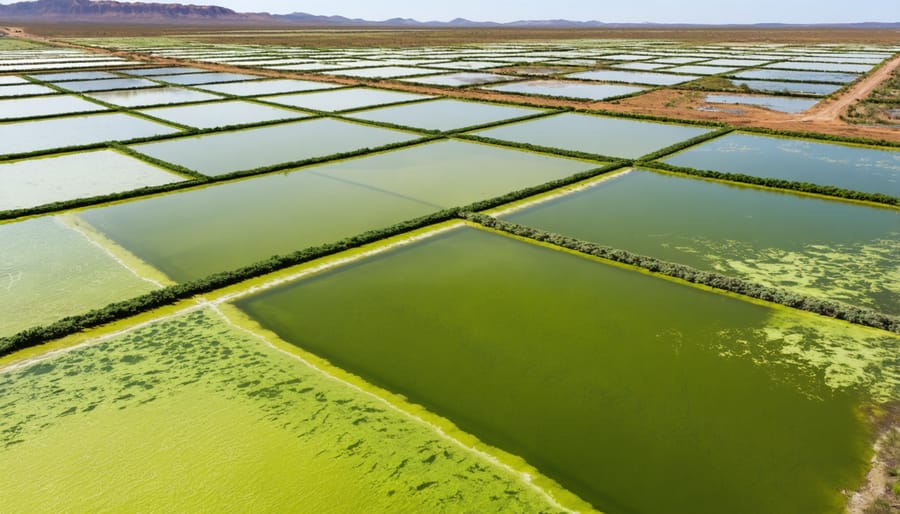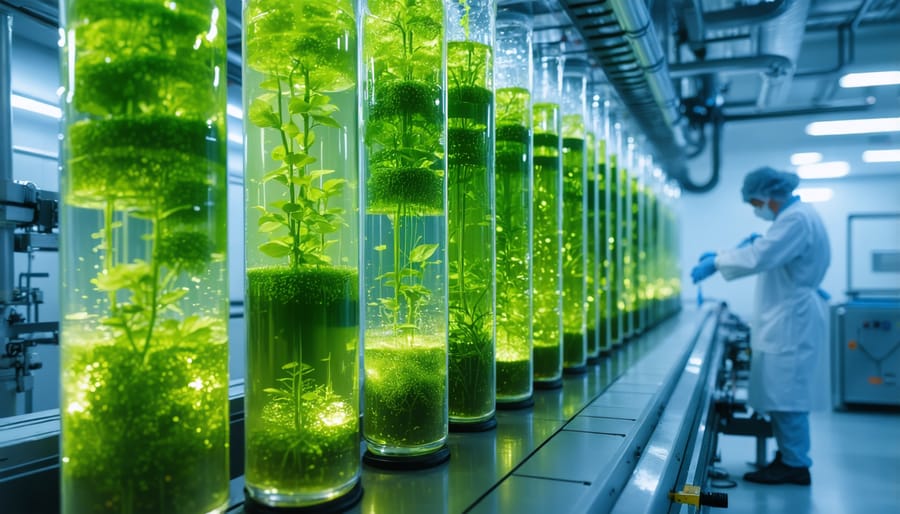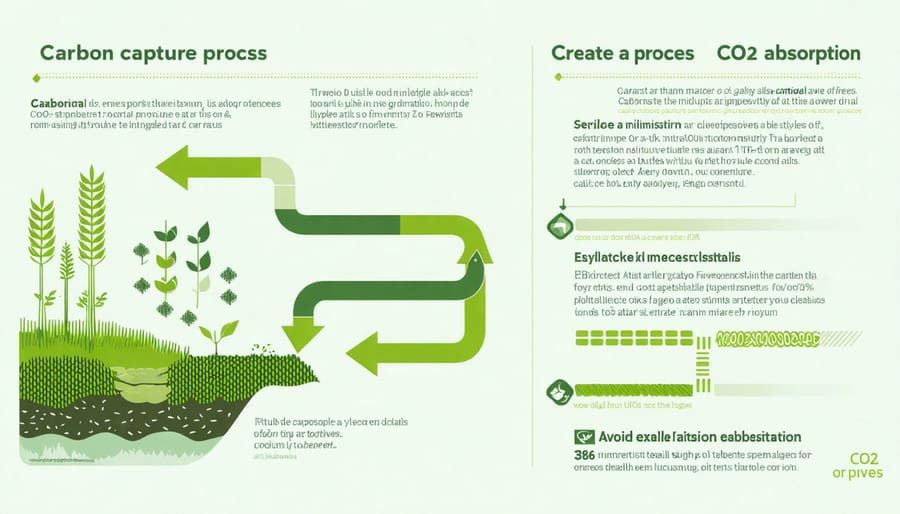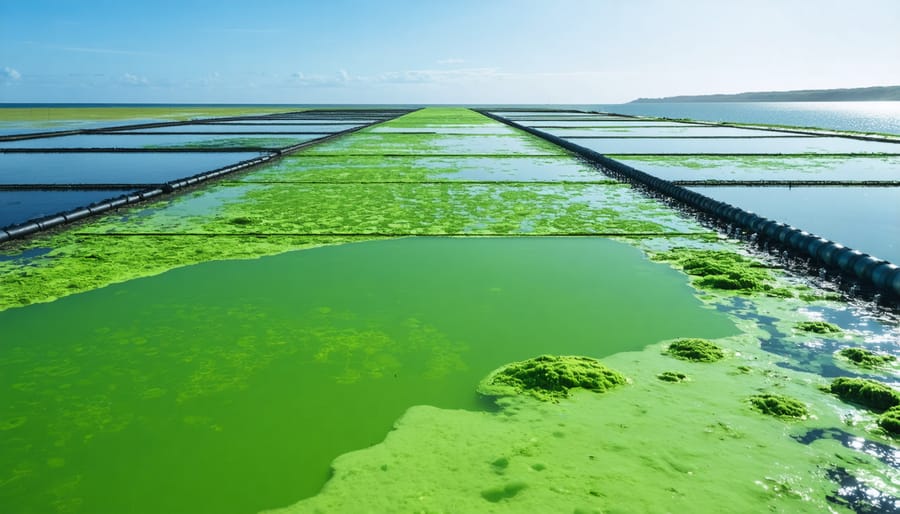In the sun-drenched waters off Australia’s coastline, a green revolution is quietly transforming our energy landscape. Algae technology, once dismissed as mere pond scum, now stands at the forefront of sustainable innovation, offering solutions to some of our most pressing environmental challenges. These remarkable microorganisms are proving to be nature’s most efficient solar-powered factories, converting sunlight and CO2 into valuable biofuels, nutritious food products, and cutting-edge materials.
From Perth to Brisbane, pioneering researchers and forward-thinking companies are harnessing algae’s extraordinary potential, developing breakthrough technologies that promise to revolutionize multiple industries. These microscopic powerhouses can produce up to 60 times more oil per hectare than traditional crops, while simultaneously cleaning wastewater and absorbing atmospheric carbon dioxide.
The implications are profound: algae technology isn’t just about creating sustainable fuel alternatives – it’s about reimagining our entire approach to resource utilization. As Australia positions itself as a global leader in sustainable innovation, algae technology represents a crucial piece of our clean energy puzzle, offering a glimpse into a future where environmental stewardship and economic growth go hand in hand.
Australia’s Natural Advantage in Algae Production
Perfect Climate Conditions
Australia’s unique geography and climate provide ideal conditions for large-scale algae cultivation. With over 35,000 kilometres of coastline and abundant sunshine, our continent offers perfect growing conditions throughout the year. Most algae species thrive in temperatures between 20-30°C, which closely matches the climate along Australia’s northern and eastern coasts.
The country’s high solar radiation levels, particularly in Queensland and Western Australia, provide optimal conditions for photosynthesis, enabling faster algae growth rates compared to many other regions worldwide. Coastal areas offer additional advantages, including access to saltwater resources and consistent humidity levels that help maintain stable growing conditions.
In regions like Port Augusta and Whyalla, where solar exposure can exceed 2,300 hours annually, algae farms can operate at peak efficiency. The natural temperature regulation provided by coastal winds helps maintain ideal growing conditions, while the abundance of non-arable land near the coast presents opportunities for large-scale facilities without competing with traditional agriculture.
These natural advantages position Australia as a potential global leader in algae technology, offering year-round production capabilities that many other countries can’t match.
Available Land and Water Resources
Australia’s vast coastline and abundant sunlight create ideal conditions for large-scale algae cultivation. Our continent boasts over 35,000 kilometers of coastline, with numerous suitable locations for both coastal and inland algae farms. Western Australia and Queensland, in particular, offer extensive areas of non-arable land that’s perfect for algae production without competing with food crops.
Water resources for algae cultivation are diverse and sustainable. While seawater is the primary source for coastal operations, inland facilities can utilize brackish groundwater, treated wastewater, and even mining process water. This flexibility in water sources makes algae farming particularly attractive in drought-prone regions where traditional agriculture struggles.
What makes Australia’s situation unique is the potential for co-location with existing industrial facilities. Power stations, desalination plants, and wastewater treatment facilities provide both the space and resources needed for algae cultivation. These partnerships create efficient symbiotic relationships where waste nutrients and CO2 from industrial processes feed the algae, while the algae help clean water and reduce emissions.
The key to success lies in strategic site selection that considers access to water, sunlight exposure, and proximity to infrastructure.

Breakthrough Algal Technologies
Advanced Cultivation Systems
The landscape of algae cultivation has evolved dramatically, with advanced cultivation techniques revolutionising production efficiency and sustainability. Modern systems now employ photobioreactors – sleek, transparent tubes where algae grow in controlled conditions, maximising sunlight exposure and nutrient uptake while minimising water usage.
Australian researchers have pioneered vertical farming systems that stack these bioreactors in towers, dramatically reducing the footprint needed for large-scale production. These systems use smart sensors and automated controls to maintain optimal growing conditions, resulting in yields up to ten times higher than traditional pond methods.
Cutting-edge harvesting techniques have also emerged, including ultrasonic aggregation and membrane filtration, which significantly reduce energy consumption during collection. Some facilities now use innovative floating cultivation platforms that automatically adjust to sunlight angles throughout the day, while others employ LED lighting systems with specific wavelengths to boost growth rates.
Perhaps most exciting is the development of hybrid systems that combine algae cultivation with wastewater treatment. These setups, already operating in Queensland, serve double duty by cleaning industrial water while producing valuable biomass. The systems use advanced nutrient recycling methods that capture and reuse resources, creating a near-closed loop production cycle.
These innovations have made commercial-scale algae farming more viable than ever, with some Australian facilities now producing several tonnes of biomass weekly. The integration of artificial intelligence for monitoring and controlling growth conditions has further streamlined operations, making these systems increasingly attractive for both urban and rural applications.

Processing Innovations
Recent breakthroughs in algae-based biofuel production have revolutionized the way we approach renewable energy. Australian researchers have developed more efficient harvesting methods using advanced photobioreactors that maximize algal growth while minimizing water usage – a crucial consideration for our sun-drenched continent.
One of the most promising innovations is the development of continuous flow systems that allow for year-round production. These systems use smart sensors to monitor and adjust growing conditions automatically, resulting in up to 40% higher yields compared to traditional batch processing methods.
The extraction process has also seen significant improvements with the introduction of ultrasonic cell disruption technology. This gentle yet effective method breaks down algal cell walls without damaging the valuable oils inside, leading to higher quality biofuel and reduced energy consumption during processing.
Local innovation hubs have pioneered a hybrid solar-algal system that uses excess heat from solar panels to maintain optimal growing temperatures for algae cultivation. This clever integration not only improves efficiency but also addresses the challenge of space utilization, making it particularly attractive for regional communities.
Perhaps most exciting is the development of selective breeding programs that have produced strains of algae with naturally higher oil content. These super-producers can generate up to twice the amount of biofuel per hectare compared to their wild counterparts, making commercial-scale production increasingly viable for Australian energy providers.
Real-World Success Stories
Commercial Scale Projects
Several large-scale algae farms are already proving the commercial viability of this technology. In Western Australia, Aurora Algae’s demonstration facility in Karratha showcases the potential of algal production in our harsh climate. The facility produces omega-3 oils, protein-rich biomass, and biofuel feedstock while utilizing the abundant sunlight and available land resources of the region.
In Queensland, Pacific Biotechnologies operates one of the Southern Hemisphere’s largest microalgae production facilities. Their 14-hectare farm demonstrates how algae can be successfully cultivated using sustainable practices while creating valuable products for the nutraceutical and aquaculture industries.
MBD Energy’s facility at Tarong Power Station has pioneered the integration of algae farming with industrial operations. By capturing CO2 emissions from the power plant, the algae farm not only produces valuable biomass but also helps reduce the facility’s carbon footprint.
Internationally, Sapphire Energy’s Green Crude Farm in New Mexico represents one of the world’s largest examples of commercial algae production. The 300-acre facility demonstrates how desert environments, similar to many parts of Australia, can be ideal locations for algae cultivation.
These successful operations showcase the scalability of algae technology and its potential to create sustainable, profitable ventures while contributing to environmental goals. They serve as blueprints for future projects and highlight Australia’s growing role in the global algae industry.
Research Breakthroughs
Australian research institutions have made remarkable strides in advancing algae technology, positioning the nation at the forefront of this sustainable innovation. The University of Technology Sydney’s Climate Change Cluster (C3) achieved a breakthrough in 2022 by developing a new strain of microalgae that produces twice the amount of biofuel compared to conventional varieties while requiring 30% less space for cultivation.
CSIRO’s flagship research facility in Queensland demonstrated success in scaling up algae production using innovative photobioreactor technology. Their team successfully cultivated algae in seawater, reducing freshwater consumption and making the process more environmentally sustainable. This achievement has attracted international attention and investment in Australian algae research.
Murdoch University researchers made headlines with their discovery of a native Australian algae species that thrives in high-temperature conditions, making it perfectly suited for the country’s climate. This hardy strain shows promise for both biofuel production and carbon capture applications, potentially offering a dual solution to energy and environmental challenges.
The University of Melbourne’s breakthrough in algal biofilm technology has simplified the harvesting process, reducing production costs by up to 40%. This development brings commercial viability closer to reality and has already sparked interest from several industrial partners looking to implement the technology at scale.
These achievements demonstrate Australia’s commitment to advancing sustainable energy solutions through innovative algae research.
Environmental and Economic Benefits
Carbon Capture Potential
Algae farms are emerging as one of nature’s most powerful tools in our fight against climate change. These remarkable organisms can capture carbon dioxide up to 400 times more efficiently than trees, making them a game-changer in carbon reduction strategies. In Australia, where vast stretches of coastline and abundant sunlight create ideal growing conditions, algae farms are showing tremendous promise in greenhouse gas reduction.
A single hectare of algae can absorb up to 100 tonnes of CO2 annually, equivalent to the emissions from roughly 60 cars. What’s particularly exciting is that this carbon capture happens while the algae are simultaneously producing valuable biomass for sustainable products and biofuels. It’s like getting two environmental wins for the price of one.
Australian research facilities, such as the algae farm projects in Queensland, are demonstrating how these microscopic powerhouses can transform CO2 from industrial emissions into useful biomass. The process is beautifully simple: as algae photosynthesise, they consume CO2 and release oxygen, all while creating valuable biomaterial that can be used in everything from food supplements to renewable fuels.
This natural carbon-capturing capability positions algae farms as a crucial player in Australia’s journey toward net-zero emissions, offering a practical and scalable solution to one of our most pressing environmental challenges.

Job Creation and Economic Growth
The growth of algae technology in Australia is creating a wave of employment opportunities across multiple sectors. From laboratory technicians and bioprocess engineers to cultivation specialists and sustainability consultants, the industry is generating diverse career pathways. Recent projections suggest that the algae biotechnology sector could create up to 5,000 new jobs in Australia by 2030, particularly in regional areas where large-scale cultivation facilities are being established.
These jobs aren’t just limited to direct algae production. The expansion of sustainable bioeconomy initiatives is fostering growth in related industries such as processing, logistics, research and development, and environmental consulting. Communities like Townsville and Port Augusta are already experiencing the economic benefits, with new algae farms providing employment opportunities and stimulating local businesses.
The industry’s growth is also attracting significant investment in training and education. TAFE institutions and universities across Australia are developing specialized courses in algal biotechnology, ensuring a skilled workforce for this emerging sector. Start-ups focused on algae-based products are flourishing, from health supplements to biofuel production, creating entrepreneurial opportunities for innovative Australians.
This job creation extends beyond traditional roles, encompassing positions in marketing, sales, and regulatory compliance, making the algae technology sector a robust contributor to Australia’s green economy transformation.
Australia stands at the forefront of a green revolution, with algae technology emerging as a beacon of hope for our sustainable future. The remarkable progress made in research facilities across the nation, from Perth to Brisbane, demonstrates that algae-based solutions are not just theoretical possibilities but practical realities waiting to be scaled up.
The coming decade holds immense promise for this transformative technology. As production costs continue to decrease and cultivation techniques become more efficient, we’re likely to see algae-based products becoming increasingly competitive in the marketplace. From carbon capture facilities in industrial zones to sustainable aviation fuel production, algae technology is set to play a pivotal role in Australia’s journey toward net-zero emissions.
What makes this technology particularly exciting for Australia is our natural advantage – abundant sunshine, vast coastlines, and available land that’s perfect for algae cultivation. These assets, combined with our world-class research capabilities and strong innovation ecosystem, position us uniquely to become a global leader in algae technology.
The future outlook is overwhelmingly positive, with projections suggesting that the algae industry could create thousands of new jobs while contributing significantly to our renewable energy targets. As we continue to innovate and adapt, algae technology represents not just an environmental solution, but a tremendous economic opportunity for Australia’s sustainable development.
The time is ripe for increased investment, stronger industry partnerships, and broader community engagement to fully realize the potential of this game-changing technology.

